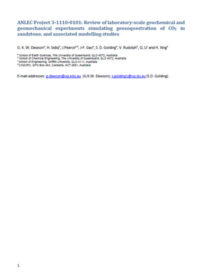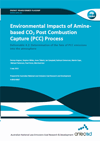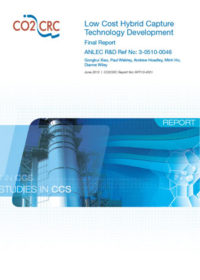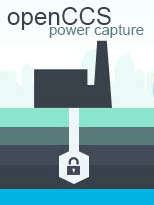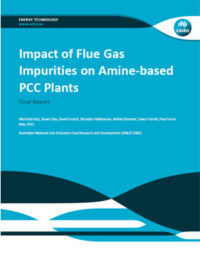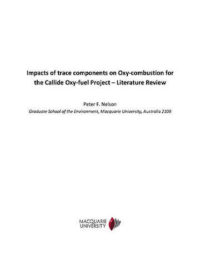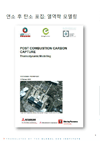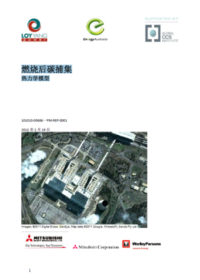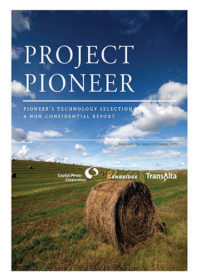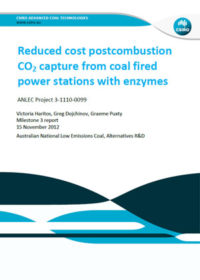Resources
Publications
Our publications, reports and research library hosts over 500 specialist reports and research papers on all topics associated with CCS.
View our Publication Library Disclaimer.
Filter by
Review of laboratory-scale geochemical and geomechanical experiments simulating geosequestration of CO2 in sandstone, and associated modelling studies
9th August 2013
Topic(s): Carbon capture use and storage (CCUS), CO2 capture
Disclaimer
The content within the Global CCS Institute Publications, Reports and Research Library is provided for information purposes only. We make every effort and take reasonable care to keep the content of this section up-to-date and error-free. However, we make no claim as to its accuracy, currency or reliability.
Content and material featured within this section of our website includes reports and research published by third parties. The content and material may include opinions and recommendations of third parties that do not reflect those held by the Global CCS Institute.
Environmental impacts of amine-based CO2 post combustion capture (PCC) process. Deliverable 4.2: Determination of the fate of PCC emissions into the atmosphere
5th July 2013
Topic(s): Carbon capture use and storage (CCUS), CO2 capture, Health safety and environment
This report is concerned with research performed as one of the five activities of the project funded by ANLEC R&D entitled “Environmental Impacts of Amine-based CO2 Post Combustion Capture (PCC) Process”.
This report is project deliverable 4.2 which details research undertaken as Activity 4: Determination of the fate of PCC emissions in the atmosphere. Outcomes from this work were used to perform a dispersion modelling scenario (deliverable 4.3) for the anticipated emissions from a black coal-fired power station retrofitted with an MEA-based CO2 capture plant.
Disclaimer
The content within the Global CCS Institute Publications, Reports and Research Library is provided for information purposes only. We make every effort and take reasonable care to keep the content of this section up-to-date and error-free. However, we make no claim as to its accuracy, currency or reliability.
Content and material featured within this section of our website includes reports and research published by third parties. The content and material may include opinions and recommendations of third parties that do not reflect those held by the Global CCS Institute.
《燃烧前CO2捕集技术研发与示范》是中国华能集团清洁能源技术研究院院长许世森博士于2013年7月2日在中国陕西延安由中国国家发改委气候司与全球碳捕集与封存研究院联合召开的碳捕集、利用和封存现场研讨会上的演讲报告。这份报告重点介绍了中国华能绿色煤电的天津IGCC项目的进展及后续计划。报告提出了虽然燃烧后比燃烧前捕集CO2的单位成本高,但常规火电结合CCS与IGCC结合CCS相比,前者总成本未必高。此外,报告还就中国的CCS未来的发展给出了明确的建议。
Disclaimer
The content within the Global CCS Institute Publications, Reports and Research Library is provided for information purposes only. We make every effort and take reasonable care to keep the content of this section up-to-date and error-free. However, we make no claim as to its accuracy, currency or reliability.
Content and material featured within this section of our website includes reports and research published by third parties. The content and material may include opinions and recommendations of third parties that do not reflect those held by the Global CCS Institute.
Low cost hybrid capture technology development
1st June 2013
Topic(s): Carbon capture use and storage (CCUS), CO2 capture
Post-combustion CO2 capture (PCC) has been recognised as a necessary option for reducing the emissions from fossil fuel power plants, especially from coal-fired power plants. The current preferred technology for CO2 capture from PCC is solvent scrubbing, of which the unit size is likely to be larger than the currently operating scrubbing units. This project looks to examine the opportunities to integrate solvent scrubbing with alternative technologies such as CO2 capture by adsorption for a lower energy penalty with additional benefits. This study shows that the hybrid system as proposed was not effective in reducing the overall cost of CO2 capture.
Disclaimer
The content within the Global CCS Institute Publications, Reports and Research Library is provided for information purposes only. We make every effort and take reasonable care to keep the content of this section up-to-date and error-free. However, we make no claim as to its accuracy, currency or reliability.
Content and material featured within this section of our website includes reports and research published by third parties. The content and material may include opinions and recommendations of third parties that do not reflect those held by the Global CCS Institute.
openCCS is the handbook for deliverying CCS projects brought to you by the Global CCS Institute. It has been built to guide you through the key processes and steps needed to deliver each component of an integrated CCS project. It’s a platform for sharing methodologies, best practices and lessons learnt from experience.
The Power Capture Section of the openCCS handbook contains:
Concept Studies
- Identify potential of the new or expanded business
- Consider new-build or retrofit for capture
- Consider saline reservoir or EOR or other for storage/beneficial reuse
- Document general features of the project
- Estimate order of magnitude costs of the project (both capital (+/-30-35% accuracy) and operating (+/-15-20% accuracy))
Prefeasibility Studies
- Consider different capture technologies
- Consider different EPC contractors
- Consider different process, location and project configuration options
- Consider different capacities for the project
- Assess the likely technical and economic viability of the project
- Recommend the preferred option and size for final study
- Estimate costs of the project (both capital (+/-20-25% accuracy) and operating (+/-10-15% accuracy))
Feasibility Studies
- Undertake front end engineering design (FEED) studies, clearly recommending one processing, location and project configuration, and prevent the need to be materially varied after project commitment
- Estimate costs of the project (both capital (+/-10-15% accuracy) and operating (+/-5-10%; closer to 5% accuracy))
- Select construction contractor and delivery approach (i.e. EPC)
- Obtain all required regulatory approvals
- Provide the basis for making an investment decision, and make final investment decision for construction of capture facility
Project Execution
- Complete the design detail for building the carbon capture asset
- Build the organisation and systems to manage the carbon capture asset
- Build the carbon capture asset
- On time
- On budget
- To scope and quality
- Commission the carbon capture asset to operating state
Asset Operation
- Ramp-up operation of the carbon capture asset to ascertain true performance
- Modify the carbon capture asset (as necessary) to achieve required performance
- Operate the carbon capture asset to achieve required performance over asset life
- Maintain the carbon capture asset to achieve required asset life
- Modify the carbon capture asset to comply with legislated regulatory changes
- Modify the carbon capture asset to realise identified opportunities
Asset Decommissioning
- Operation of asset (i.e. power plant with capture) ceased
- Modify the asset (as necessary) to achieve required decommissioned state
- On time
- On budget
- To scope and quality
- Asset sites decommissioned and rehabilitated to required condition
- Establish organisation for post-closure stage (as necessary)
Disclaimer
The content within the Global CCS Institute Publications, Reports and Research Library is provided for information purposes only. We make every effort and take reasonable care to keep the content of this section up-to-date and error-free. However, we make no claim as to its accuracy, currency or reliability.
Content and material featured within this section of our website includes reports and research published by third parties. The content and material may include opinions and recommendations of third parties that do not reflect those held by the Global CCS Institute.
Impact of flue gas impurities on amine-based PCC plants
1st May 2013
Topic(s): Carbon capture use and storage (CCUS), CO2 capture
Disclaimer
The content within the Global CCS Institute Publications, Reports and Research Library is provided for information purposes only. We make every effort and take reasonable care to keep the content of this section up-to-date and error-free. However, we make no claim as to its accuracy, currency or reliability.
Content and material featured within this section of our website includes reports and research published by third parties. The content and material may include opinions and recommendations of third parties that do not reflect those held by the Global CCS Institute.
Impacts of trace components on oxy-combustion for the Callide Oxy-fuel Project: literature review
20th February 2013
Topic(s): Carbon capture use and storage (CCUS), CO2 capture
Disclaimer
The content within the Global CCS Institute Publications, Reports and Research Library is provided for information purposes only. We make every effort and take reasonable care to keep the content of this section up-to-date and error-free. However, we make no claim as to its accuracy, currency or reliability.
Content and material featured within this section of our website includes reports and research published by third parties. The content and material may include opinions and recommendations of third parties that do not reflect those held by the Global CCS Institute.
Post combustion carbon capture: thermodynamic modelling
19th February 2013
Topic(s): Carbon capture use and storage (CCUS), CO2 capture
Disclaimer
The content within the Global CCS Institute Publications, Reports and Research Library is provided for information purposes only. We make every effort and take reasonable care to keep the content of this section up-to-date and error-free. However, we make no claim as to its accuracy, currency or reliability.
Content and material featured within this section of our website includes reports and research published by third parties. The content and material may include opinions and recommendations of third parties that do not reflect those held by the Global CCS Institute.
본 보고서는 연소 후 포집(Post Combustion Capture, PCC) 기술 개조가 발전소 성능에 미치는 영향과 그 투입값에 관한 독자적인 검증법을 제공한다. 이는 미개발 구역에서 이미 적용되는 방식이며, 시설 운영 시 성능 리스크 평가와 잠재적 수익 파악의 근거를 파악한다. 보고서에서는 방법론 전개 및 설명을 위해 Loy Yang A 발전소에 5000 tpd PCC를 장착한 사례를 연구하고 거기에서 도출되는 결론을 제시할 것이다.
본 보고서에서 제시하는 방법론 및 결론은 CCS 포집 기술 전문가가 심도있게 검증한 것으로, 성능 자료를 제시하고 기술 공급업체의 지적재산권을 보호하는 동시에 프로젝트 평가 시 CCS 업계에 충분한 신뢰감을 주는 타당한 접근 방식이라는 평을 받았다.
Disclaimer
The content within the Global CCS Institute Publications, Reports and Research Library is provided for information purposes only. We make every effort and take reasonable care to keep the content of this section up-to-date and error-free. However, we make no claim as to its accuracy, currency or reliability.
Content and material featured within this section of our website includes reports and research published by third parties. The content and material may include opinions and recommendations of third parties that do not reflect those held by the Global CCS Institute.
该报告提供了对改造燃烧后碳捕集(PCC)发电厂性能的影响和监管进行独立验证的方法。该方法学也可以适用于新建站点。它也将提供运行风险的价值和影响设施运营的潜在收入的基础。
重要的是,在本报告描述的方法学和结果已被一位知名的CCS捕集技术专家进行了专家审查,这位专家发现该方法学在提供性能数据和保护技术提供者知识产权上有一套健全的处理方法,同时能在评估项目中对更广泛的CCS同行提供充分的依据。
Disclaimer
The content within the Global CCS Institute Publications, Reports and Research Library is provided for information purposes only. We make every effort and take reasonable care to keep the content of this section up-to-date and error-free. However, we make no claim as to its accuracy, currency or reliability.
Content and material featured within this section of our website includes reports and research published by third parties. The content and material may include opinions and recommendations of third parties that do not reflect those held by the Global CCS Institute.
Project Pioneer. Pioneer’s technology selection: a non-confidential report
1st January 2013
Topic(s): Carbon capture use and storage (CCUS), CO2 capture
Construction of the carbon catpure facility (CFF) was planned to commence mid-2013, and was planned to be completed and commissioned ready for commercial operation in December 2015. The EPC contract negotiated but not signed with MHI was a fixed price, turnkey contract and included the design, procurement, construction, commissioning, warranty, and performance guarantee of the complete CCF plant.
Disclaimer
The content within the Global CCS Institute Publications, Reports and Research Library is provided for information purposes only. We make every effort and take reasonable care to keep the content of this section up-to-date and error-free. However, we make no claim as to its accuracy, currency or reliability.
Content and material featured within this section of our website includes reports and research published by third parties. The content and material may include opinions and recommendations of third parties that do not reflect those held by the Global CCS Institute.
Reduced cost postcombustion CO2 capture from coal fired power stations with enzymes
15th November 2012
Topic(s): Carbon capture use and storage (CCUS), CO2 capture
Disclaimer
The content within the Global CCS Institute Publications, Reports and Research Library is provided for information purposes only. We make every effort and take reasonable care to keep the content of this section up-to-date and error-free. However, we make no claim as to its accuracy, currency or reliability.
Content and material featured within this section of our website includes reports and research published by third parties. The content and material may include opinions and recommendations of third parties that do not reflect those held by the Global CCS Institute.
